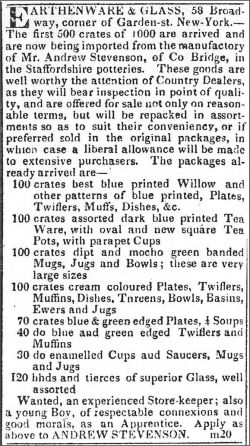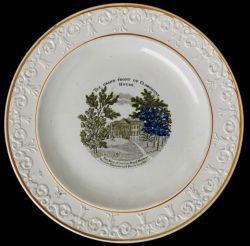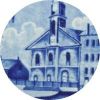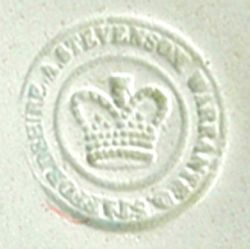Andrew Stevenson
|
Andrew Stevenson seems to have been a solitary person. There is no record of his marriage in the standard registers, and, compared with his brother Ralph, he had few interactions in the North Staffordshire community. He remained in business with Robert Bucknall until 1816[vi] after which time he was in business for himself and continued to be listed as an earthenware manufacturer in directories until 1828[vii]. There was fleeting reference in Allbut’s 1822 Directory[viii] to Stevenson, Andrew, china & earthenware manufact. Cobridge, but either this was an error or the china making venture did not last long as only earthenware by Andrew Stevenson is known. Maintaining his Cobridge pottery Business, in early 1823 Andrew Stevenson sailed from Liverpool to New York on the packet ship James Cropper. Reports of the ship's speedy 36 day sailing were listed in many newspapers, recording A. Stevenson as one of the passengers and noting that the cargo included earthenware.[ix] Perhaps Andrew Stevenson brought crates of pottery with him to set up his shop at 85 Broadway, New York, advertisements in May and June 1823 indicate that he was selling pottery from his own factory and willing to take orders to be supplied by his Cobridge Works.[x] In 1823 Spooner’s Brooklyn Village Directory, lists Andrew Stevenson, China & earthenware manufacturer/Address Mansion House, Brooklyn Heights/Store 58, Broadway New York, Brooklyn New York. Stevenson must soon have traveled back to England, for in March 1824, he was once again arriving in New York from Liverpool, this time on the Ship Columbia. Perhaps it is at this time Andrew Stevenson decides to make America his home. His pottery continued to operate until sometime 1827-28 by which time he had purchased the Cobridge Works and leased it to James and Ralph Clews. Stevenson is not mentioned again in Staffordshire or as a retailer in New York. There is no more news of his activities until his death is recorded in the Staffordshire Advertiser of March 24, 1855, Andrew Stevenson, Westchester, New York, USA died 28 Feb formerly e’ware mfr Cobridge. The pottery he made was typical of the earthenware produced widely through the Staffordshire Potteries and included plain and painted creamware and pearlware with edged, painted and printed decoration. Examples of his work are known with a circular impressed mark that incorporates the name A. Stevenson, and from these marked examples we can appreciate the wide range of his productions. In addition, the impressed mark is also recorded on pieces with a blue printed mark STEVENSON’S Stone China, suggesting that wares with this mark were also made by Andrew. However, there remains some doubt as to which Stevenson made pottery with the simple linear impressed mark STEVENSON, or the more complex impressed mark that incorporates STEVENSON with a 3-masted ship,although the latter is often attributed to Andrew. [i] Jones's directory; or, useful pocket companion, for the year 1789 … containing an alphabetical list of the names and places of abode of the merchants, manufacturers, traders, and shopkeepers, in and about the city of Glasgow. Printed for the editor by John Mennons, in Glasgow. [ii] Holden, W. 1805 Holden’s Triennial Directory for 1809, 1810, 1811, Second Volume. London, W. Holden [iii] Emery, N. “The Stevensons of Staffordshire”, The Magazine Antiques, June 1955, pp. 494-495 [iv] Wedgwood Manuscripts 33/25182 [v] See entry for Ralph & James Clews on this site [vi] Staffordshire Advertiser 7 September, 1816 [vii] See list of Directories in Information Resources section of this online exhibit [viii] Allbut, T. 1822. The Newcastle and Pottery General and Commercial Directory, for 1822-23. Hanley, T. Allbut [ix] National Gazette & Literary Register, New York, February 10, 1823; Baltimore Patriot, February 11, 1823. [x] New York Gazette and General Advertiser, May 23, 1823, June 27, 1823. |
 Teapot with the impressed circular mark of Andrew Stevenson, possibly the "new square" shape advertised in New York in 1823, see below.   plate with impressed circular mark of Andrew Stevenson ©Victoria and Albert Museum, London
|

 Andrew Stevenson,
the youngest of four children, was born in 1780 to Ralph and Ann Stevenson of
Burslem. Ralph died in 1784, and when Mary
married the potter Benjamin Godwin in 1790 she sent her three sons to live with
her uncle John Adams in Glasgow. It’s possible that he was the John Adams
listed as, “dealer in Foreign and English china and stone-ware, warehouse, east
side of Candlerigs” in the 1789 Glasgow Directory
Andrew Stevenson,
the youngest of four children, was born in 1780 to Ralph and Ann Stevenson of
Burslem. Ralph died in 1784, and when Mary
married the potter Benjamin Godwin in 1790 she sent her three sons to live with
her uncle John Adams in Glasgow. It’s possible that he was the John Adams
listed as, “dealer in Foreign and English china and stone-ware, warehouse, east
side of Candlerigs” in the 1789 Glasgow Directory